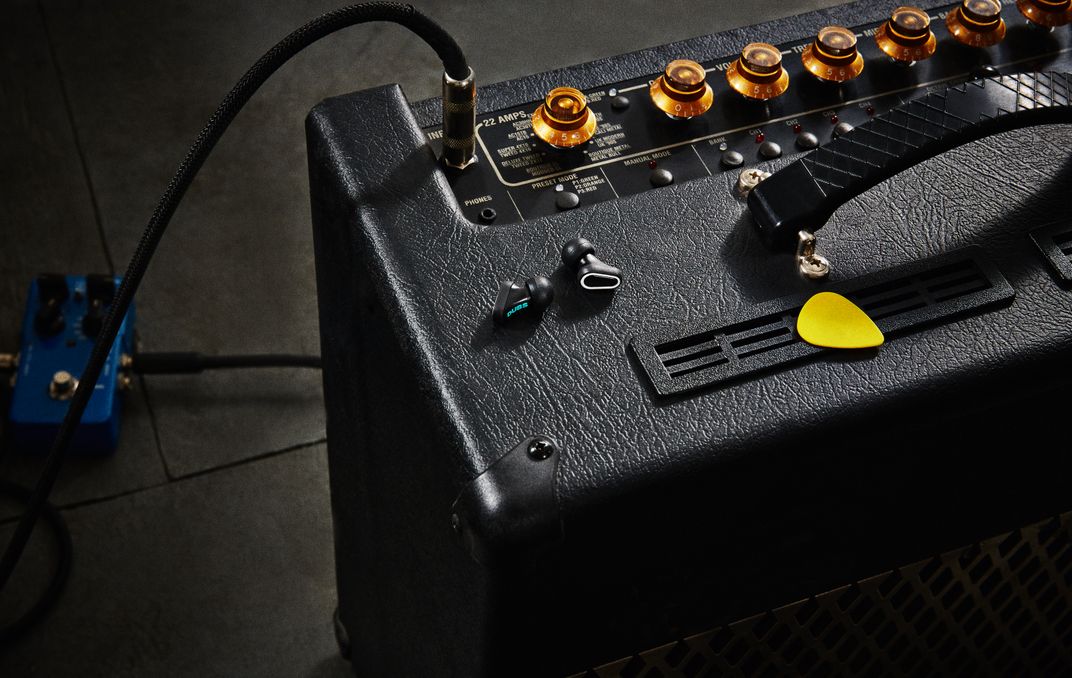Building a Better Earplug
Using a series of acoustic filters, DUBS lower the intensity of sounds without muddying them
/https://tf-cmsv2-smithsonianmag-media.s3.amazonaws.com/filer/a3/a0/a3a0a585-7dd6-405d-adfb-919908e9f59f/detail5-hires.jpg)
Any smart concertgoer knows that earplugs are a necessity. But in protecting your ears, you’re doing the music—and yourself, for that matter—a grave disservice. “What you’re hearing is the world though a pillow,” says Dan Wiggins, cofounder and chief technology officer at Doppler Labs, a startup out to reinvent the way we protect our ears.
Late last month, Doppler launched the DUBS Acoustic Filters, earplugs that keep damaging noise out, while still letting what you want to hear in. Inside each DUBS earbud, 17 individual parts work together to filter aggressively loud sounds before they can reach the inner ear.
It’s a change that’s long overdue. According to the Better Hearing Institute, some 6 million people between the ages of 18 and 44 suffer from some degree of hearing loss. In fact, it’s now the third most common physical condition in the United States, after arthritis and heart disease.
That damage can be attributed, at least in part, to lifestyle choices. We cram into subway cars and airplanes and surround ourselves with raucous noises inside concert venues and sports arenas. According to the National Institutes of Health, exposure to any sound—either quick or prolonged—over 85 decibels (dB) can lead to noise-induced hearing loss. (Point of reference: city traffic or a small chamber orchestra each clock about 85 dB.) This type of exposure is especially dangerous, because it’s surreptitious; a sound won’t cause immediate physical pain until it reaches 125 dB, the level of a firecracker.
As it happens, standing in the front row of a rock concert is also right at that threshold, which is why the savvy choose to plug their ears. (Standing farther back brings noise down to about 100 dB.) But Wiggins and his team have taken a different approach to the issue. “Instead of using rubber or silicone to block sounds, we modify and change the way you hear the sounds,” he explains. “We’ve adjusted an acoustical filter, which lowers the intensity without losing any of the frequencies.”

Typically, when a listener plugs his or her ears, all sounds are muted equally, which has a muddying effect, because our brains simply aren’t used to hearing sounds that way. So, Wiggins developed a series of specially tuned filters that individually control distinct segments of the audio spectrum. The result is the balanced, well-rounded music our brains are used to, just 12 dB less of it. Decibel levels increase logarithmically, so a 12 dB drop might not appear large, but it actually cuts the intensity of a sound by a factor of 20.
Inside each pair of DUBS are two filters. One, known as a low-pass filter, lets a certain amount of low frequencies, including vocals and guitars, through. At the same time, a high-pass filter handles higher pitches, such as symbols. Changing the density of each filter’s foam, explains Wiggins, changes what frequencies will pass through and how much of them.
Still, users will not be invincible. David Preves, an audiologist and engineer at hearing-aid manufacturer Starkey, warns that the DUBS's 12 dB reduction might not lower concert volumes to a level that's deemed safe by the Department of Labor's Occupational Safety and Health Administration (OSHA) for extended lengths of time. OSHA guidelines state that a person should not be exposed to 100 dB sound (a concert at about 110 to 115 dB, less a 12 dB DUBS reduction) for longer than two hours a day. In the case of prolonged exposure, similar filters from Etymotic Research can cut intensity by 9, 15 or 25 dB without much affect on clarity.
According to Doppler, however, the DUBS aesthetics should provide them with broad appeal. “Sunglasses went from something that was prescribed by doctors to a fashion product,” Fritz Lanman, an investor in Doppler, told the Los Angeles Times, “and that's what we're trying to do for ear protection.”
DUBS are encased in black bodies and nestle neatly inside the outer ear, a fit and finish that help them resemble high-end earphones more than conventional earplugs. They’re available in a choice of four colors and run $25 a pair.
That attention to detail may be key to the DUBS success, because, at the end of the day, the best earplug is the one someone will actually wear.
/https://tf-cmsv2-smithsonianmag-media.s3.amazonaws.com/accounts/headshot/me.jpg)
/https://tf-cmsv2-smithsonianmag-media.s3.amazonaws.com/accounts/headshot/me.jpg)